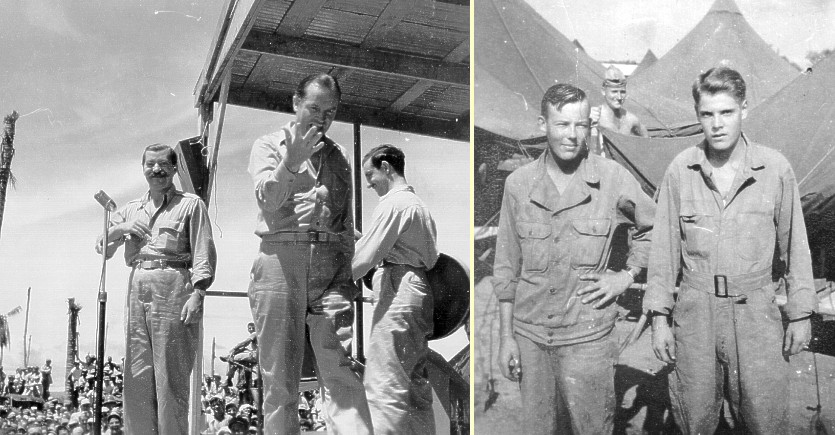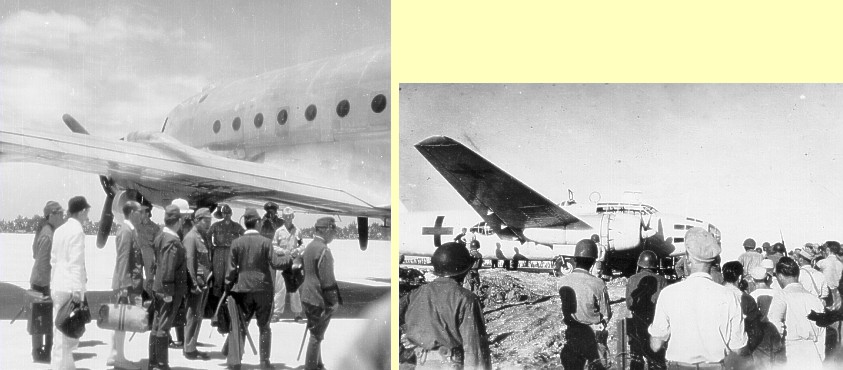
Kansas Snapshots by Gloria Freeland - Feb. 25, 2011
Footnote to history
Pages of the 65-year-old photo album were so brittle that pieces fell off when I turned them. Mounting corners popped free when I attempted to remove the old black and white pictures of young men in distant lands.
It was 68 years ago this month that one of the young men in many of the album's photos left for the service. Uncle Stan was just a few days past his 20th birthday.
He left the family farm near Burns, Kansas to train in camps in Florida, Oklahoma, Georgia and California. From San Francisco, he and 4,000-5,000 other troops traveled on the USS Holbrook to Townsville, Australia. From September 1943 through December 1945, he and the rest of the U.S. Army Air Corps, 5th Air Force, 100th Air Service Squadron served in New Guinea, Wakde Island, the Philippines and Ie Shima. Stan was an armament mechanic. He and others in his squadron repaired P-38s, fighter planes that served as protective escorts for B-24 and B-25 bombers.
Stan gave me his World War II album in 1999 because he and Aunt Kay never had children and he knew I would appreciate and safeguard it.
But it wasn't until a couple of years ago that I sat with him as he identified every picture in the album. He had previously written descriptions underneath some of the photos on its brittle pages. Others were identified on the backs of the prints.
When husband Art and I finished scanning and identifying the more than 250 images a few weeks ago, I sent Stan copies and the list.
"Some of the prints look better than the originals," Stan said.
I agreed. One photo from January of 1944 was of a native festival in New Guinea. It was hard to pick Stan out of the group without using a magnifying glass in the small original, but I spotted him right away in the larger print.
Many service men collected photos. In most regards, Stan's were typical. But while studying the images, I came to realize that Stan had been a witness to a small bit of history. Most people who are familiar with the war know about the Sept. 2, 1945 ceremony aboard the USS Missouri. It was where Gen. Douglas MacArthur and representatives of the Japanese government signed the papers that formally ended the war. In truth, the formal surrender began days earlier on Ie Shima, a small peanut-shaped island southwest of Japan, approximately midway between the Japanese home islands and Taiwan.
Worried that Japan's promised surrender might be a ploy, MacArthur required the Japanese to paint the bodies white on two Mitsubishi-manufactured "Betty" bombers and add green crosses on the sides of the fuselage. Betty was a code name Allied forces had used throughout the war for that particular bomber. These two were given the names Bataan 1 and Bataan 2 in memory of the Philippine island where the infamous death march took place.
Although Ie Shima is only about three miles long and a mile and a half wide, it was large enough for the airbase where Stan was stationed. Batann 1 and Bataan 2 were to leave the Japanese home islands in the early morning of Aug. 19, 1945 and land at the airfield on Ie Shima. The two planes were to transport more than a dozen representatives of Japan, including Gen. Torashiro Kawabe, who represented the Japanese Army Chief of Staff. They were to also bring with them the Japanese military war plans.
The two planes were watched closely during the trip by members of the United States Army Air Force - both to make certain the planes were not on a suicide mission and to assure that no elements of the Japanese forces tried to down the planes in an attempt to scuttle the surrender.
Upon arrival at Ie Shima, the delegation boarded a USAAF C-54 to fly to Manila. Once there, the plans the Japanese had brought with them were analyzed and MacArthur's blueprints for Japan's formal surrender were laid out.
The delegation was to return by reversing the route, but things almost went terribly wrong. Bataan 2 damaged a wheel while taxiing at Ie Shima and could not return until the next day. Most of the Japanese contingent did not want to stay behind and boarded Bataan 1. Some fuel problem developed and it ended up landing in shallow water, short of its destination. But those aboard survived and the surrender documents were delivered.
In the larger scheme of things, everything had gone as planned, so few will remember the role that little Ie Shima played. I'm certain had Stan not given me his photo album, I never would have known about it. So when he said, "You didn't need to do that. I'm going to send you money to pay for those," referring to the copies, I told him to forget it. For a history buff like me, I had already been well paid.

Album photos: left, USO show on Wakde Island with (l to r) Jerry Colonna, Bob Hope and Tony Romano;
right, Stan Freeland (hand on hip) next to best friend Howard Dunaway in Australia.

Left, Japanese delegation prepares to board C-54 for Manila. General Kawabe is at
the far right; right, Bataan 2 had wheel damage when it ran off the edge of taxi area.